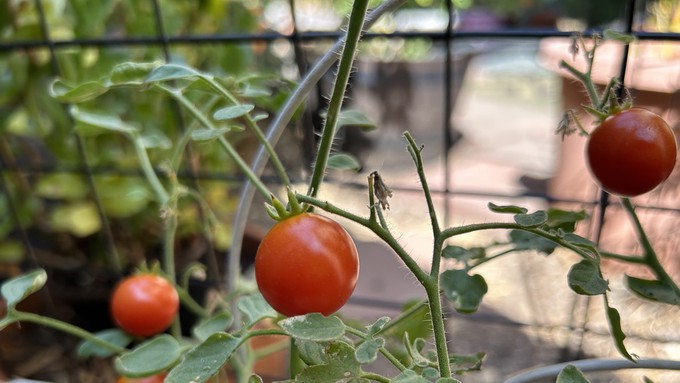
Red Flag Warning means be cautious; what Sacramento-area gardeners need to know

With smoke in the air, be sure to wash particulate dust off any produce before consuming it -- including those snack-perfect cherry tomatoes. Kathy Morrison
We’re in the midst of California fire season. If you need any reminders, just go outside.
Hazy skies are due to smoke from six major wildfires burning in Northern California plus more in southern Oregon. The closest blaze is more than 200 miles away, but the smoke is funneling into the Sacramento Valley and floating our way.
And we’re surrounded by potential fire danger. Due to our wet winter, there’s an abundance of plant material throughout our region. Recent triple-digit weather dried annual weeds and grasses tinder-crisp. That’s fuel for hungry wildfire.
“A Red Flag Warning remains in effect through 8 PM today for portions of the Sacramento Valley,” tweeted the NWS Sacramento office on Wednesday morning. “Breezy winds & very dry conditions will create critical fire weather conditions. Be sure to use extra caution if using outdoor equipment and keep vehicles off of dry grass!”
In the afternoon, winds will push some of the haze out of the Sacramento area, but we can’t breathe easier.
“The smoke and haze present across much of the Valley this morning will diminish briefly this afternoon,” says the weather service. “However, we're expecting haze/smoke to return overnight and into Thursday morning.”
To check your local air quality, go to: http://airnow.gov
Low humidity, gusty winds and plenty of dry fuel can be a recipe for catastrophe. On Wednesday, humidity levels will dip down to 5 to 17% with wind gusts of up to 35 mph, says the weather service.
“Fire safety should be exercised to prevent fires,” it adds. “Always have an emergency plan if a fire starts near you.”
All it takes is a spark. A metal blade of a lawnmower or trimmer against a rock can ignite dry grass. A vehicle parked on dry grass or weeds can start a fire, too. So can a chain dragging from the back of a trailer. Use extra caution.
As for the hazy skies, tomatoes, peppers and other ripening vegetables could be dusted with fine particulate matter. Make sure to wash anything you harvest before eating. (No backyard cherry tomato-munching right off the vine.)
Spider mites love these dry, hazy, dusty conditions. Take out the hose and give your tomato vines and rose bushes a morning shower; that will knock mites off and refresh plants.
So far, there hasn’t been enough smoke in our area to worry about smoke taint, the absorption of smoke flavors through the skin of ripening fruit. But that could be an issue for grape and fruit growers closer to the fires in Trinity, Humboldt and Siskiyou.
As we know from fire seasons past, conditions can change dramatically in a hurry. It’s better to be prepared.
For tips: https://www.readyforwildfire.org/.
Comments
0 comments have been posted.Sacramento Digs Gardening to your inbox.
Food in My Back Yard Series
May 6: Maintain soil moisture with mulch for garden success
April 29: What's (already) wrong with my tomato plants?
April 22: Should you stock up on fertilizer? (Yes!)
April 15: Grow culinary herbs in containers
April 8: When to plant summer vegetables
April 1: Don't be fooled by these garden myths
March 25: Fertilizer tips: How to 'feed' your vegetables for healthy growth
March 18: Time to give vegetable seedlings some more space
March 11: Ways to win the fight against weeds
March 4: Potatoes from the garden
Feb. 25: Plant a fruit tree now -- for later
Feb. 18: How to squeeze more food into less space
Feb. 11: When to plant? Consider staggering your transplants
Feb. 4: Starting in seed starting
Sites We Like
Garden Checklist for week of May 11
Make the most of the lower temperatures early in the week. We’ll be back in the 80s by Thursday.
* Plant, plant, plant! It’s prime planting season in the Sacramento area. Time to set out those tomato transplants along with peppers and eggplants. Pinch off any flowers on new transplants to make them concentrate on establishing roots instead of setting premature fruit.
* Direct-seed melons, cucumbers, summer squash, corn, radishes, pumpkins and annual herbs such as basil.
* Harvest cabbage, lettuce, peas and green onions.
* In the flower garden, direct-seed sunflowers, cosmos, salvia, zinnias, marigolds, celosia and asters. (You also can transplant seedlings for many of the same flowers.)
* Plant dahlia tubers.
* Transplant petunias, marigolds and perennial flowers such as astilbe, columbine, coneflowers, coreopsis, dahlias, rudbeckia and verbena.
* Keep an eye out for slugs, snails, earwigs and aphids that want to dine on tender new growth.
* Feed summer bloomers with a balanced fertilizer.
* For continued bloom, cut off spent flowers on roses as well as other flowering plants.
* Add mulch to the garden to maintain moisture. Mulch also cuts down on weeds. But don’t let it mound around the stems or trunks of trees or shrubs. Leave about a 6-inch-to-1-foot circle to avoid crown rot or other problems.
* Remember to weed! Pull those nasties before they set seed.
* Water early in the day and keep seedlings evenly moist.